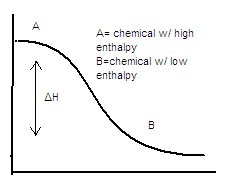- this reactant is called the limiting reactant (or reagent) ----> it stops or limits the reaction.
- the limiting reactant determines the amount of products produced.
- assume one reactant is the limiting reactant, and determine what quantity of the other is needed.
example
what is the limiting reactant when 25 g of p4 reacts with 64.6 g of Cl2 forming phosphorus trichloride?
P4 + 6 Cl2 ---> 4PCl3
P4 = 123.6 g/mol
Cl2 = 71 g/mol
 Since you need more than the given amount of Cl2 to fully react the P4, Cl2 is the limiting reagant.
Since you need more than the given amount of Cl2 to fully react the P4, Cl2 is the limiting reagant.Determine the theoretical yield of the above reaction.
PCl3 = 137.4 g/ mol
when we figure out the theoretical yield, we have to calculate the amount of the product that will be produced from the limiting reagent, because that is how much is being used before the reaction is over.

83.3 g of PCl3 will be produced. (we used the limiting reagent in the equation because that is the amount that will be used in the reaction.
example.
in the formation of water, 25g of oxygen reacts with 10g of hydrogen. determine the limiting reactant, theoretical yield and amount of excess reactants.
2O2 + 2H2 -----> 2 H2O
H2 = 2 g/ mol
O2 = 32 g/mol
 For 10g of hydrogen, we need 80 g of oxygen, so
For 10g of hydrogen, we need 80 g of oxygen, soO2 is the limiting reagent.
H2O = 18 g / mol
THEORETICAL YIELD
 28.1 g of water will be produced.
28.1 g of water will be produced.EXCESS - we plug in the calculation so we know exactly how much hydrogen we need, then we subtract this amount from the amount that is given to know how much excess there is.

10g - 3.13g = 6.87 g will be left.
***** Notice that the amounts you need (25 g O2 + 3.13g H2 = 28.1 which is the theoretical yield!!!)
here's a worksheet
and heres a video for further help:




